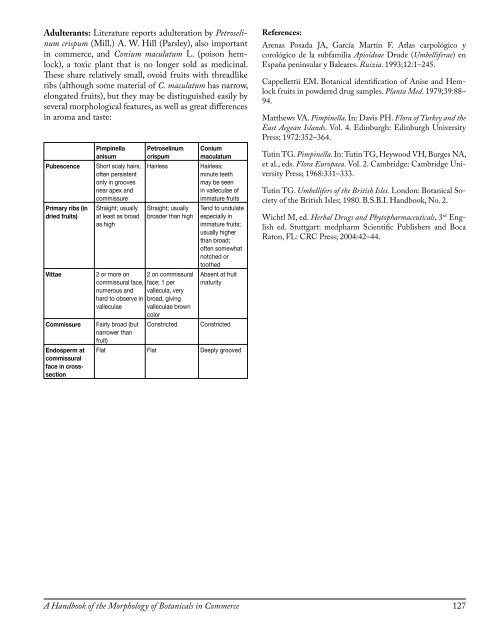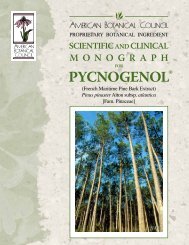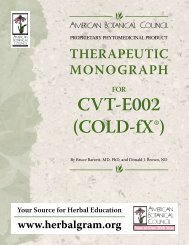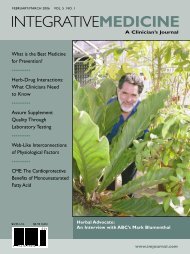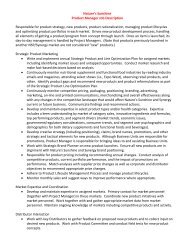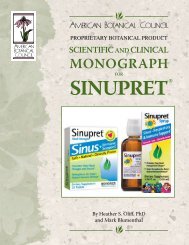The Identification of Medicinal Plants A ... - American Botanical Council
The Identification of Medicinal Plants A ... - American Botanical Council
The Identification of Medicinal Plants A ... - American Botanical Council
Create successful ePaper yourself
Turn your PDF publications into a flip-book with our unique Google optimized e-Paper software.
Adulterants: Literature reports adulteration by Petroselinum<br />
crispum (Mill.) A. W. Hill (Parsley), also important<br />
in commerce, and Conium maculatum L. (poison hemlock),<br />
a toxic plant that is no longer sold as medicinal.<br />
Th ese share relatively small, ovoid fruits with threadlike<br />
ribs (although some material <strong>of</strong> C. maculatum has narrow,<br />
elongated fruits), but they may be distinguished easily by<br />
several morphological features, as well as great diff erences<br />
in aroma and taste:<br />
Pimpinella<br />
anisum<br />
Pubescence Short scaly hairs,<br />
<strong>of</strong>ten persistent<br />
only in grooves<br />
near apex and<br />
commissure<br />
Primary ribs (in<br />
dried fruits)<br />
Straight; usually<br />
at least as broad<br />
as high<br />
Vittae 2 or more on<br />
commissural face,<br />
numerous and<br />
hard to observe in<br />
valleculae<br />
Commissure Fairly broad (but<br />
narrower than<br />
fruit)<br />
Endosperm at<br />
commissural<br />
face in crosssection<br />
Petroselinum<br />
crispum<br />
Conium<br />
maculatum<br />
Hairless Hairless;<br />
minute teeth<br />
may be seen<br />
in valleculae <strong>of</strong><br />
immature fruits<br />
Straight; usually<br />
broader than high<br />
2 on commissural<br />
face; 1 per<br />
vallecula, very<br />
broad, giving<br />
valleculae brown<br />
color<br />
Tend to undulate<br />
especially in<br />
immature fruits;<br />
usually higher<br />
than broad;<br />
<strong>of</strong>ten somewhat<br />
notched or<br />
toothed<br />
Absent at fruit<br />
maturity<br />
Constricted Constricted<br />
Flat Flat Deeply grooved<br />
References:<br />
Arenas Posada JA, García Martín F. Atlas carpológico y<br />
corológico de la subfamilia Apioideae Drude (Umbelliferae) en<br />
España peninsular y Baleares. Ruizia. 1993;12:1–245.<br />
Cappellettii EM. <strong>Botanical</strong> identifi cation <strong>of</strong> Anise and Hemlock<br />
fruits in powdered drug samples. Planta Med. 1979;39:88–<br />
94.<br />
Matthews VA. Pimpinella. In: Davis PH. Flora <strong>of</strong> Turkey and the<br />
East Aegean Islands. Vol. 4. Edinburgh: Edinburgh University<br />
Press; 1972:352–364.<br />
Tutin TG. Pimpinella. In: Tutin TG, Heywood VH, Burges NA,<br />
et al., eds. Flora Europaea. Vol. 2. Cambridge: Cambridge University<br />
Press; 1968:331–333.<br />
Tutin TG. Umbellifers <strong>of</strong> the British Isles. London: <strong>Botanical</strong> Society<br />
<strong>of</strong> the British Isles; 1980. B.S.B.I. Handbook, No. 2.<br />
Wichtl M, ed. Herbal Drugs and Phytopharmaceuticals, 3 rd English<br />
ed. Stuttgart: medpharm Scientifi c Publishers and Boca<br />
Raton, FL: CRC Press; 2004:42–44.<br />
A Handbook <strong>of</strong> the Morphology <strong>of</strong> <strong>Botanical</strong>s in Commerce 127


